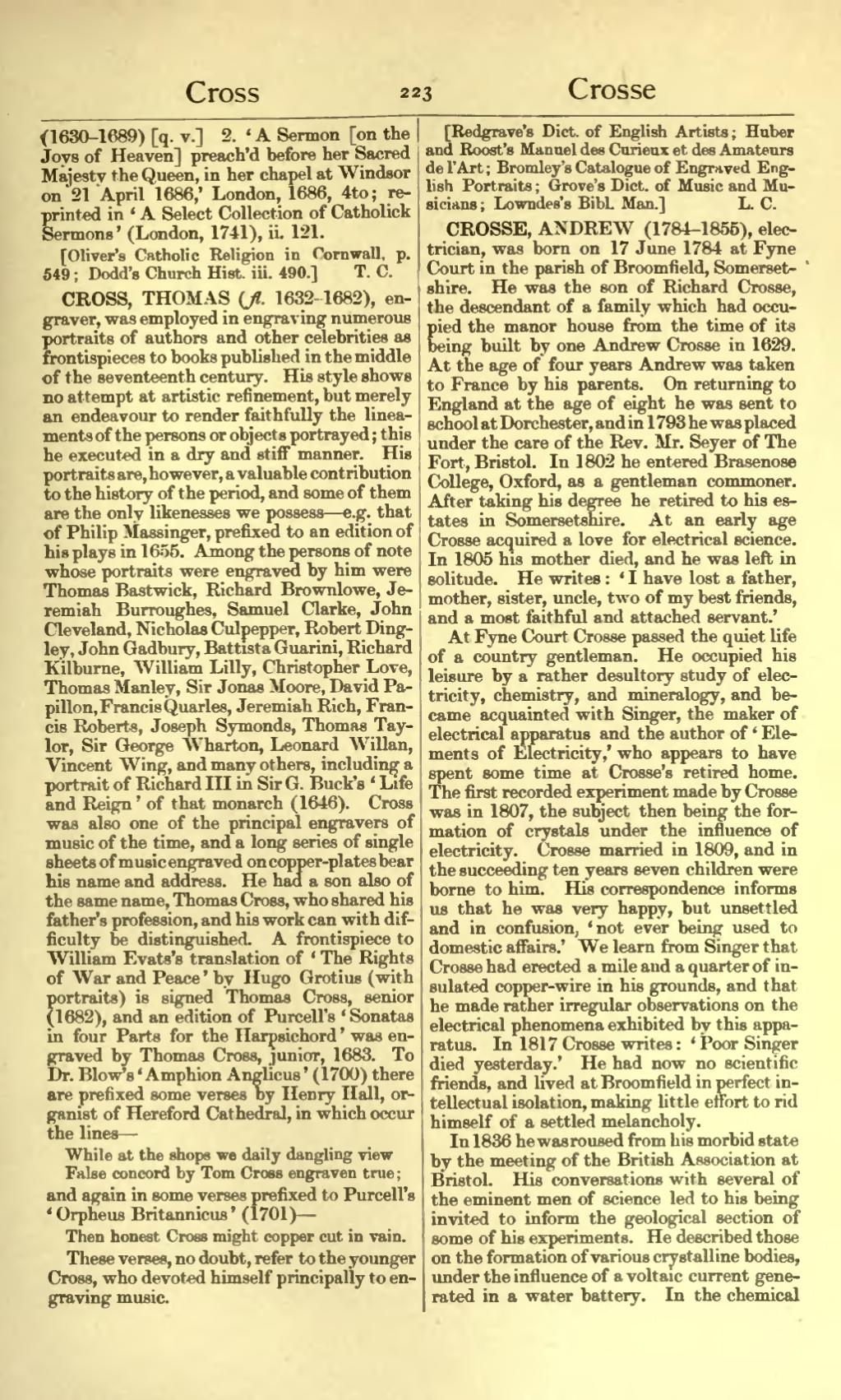(1630–1689) [q. v.] 2. ‘A Sermon [on the Joys of Heaven] preach'd before her Sacred Majesty the Queen, in her chapel at Windsor on 21 April 1686,’ London, 1686, 4to; reprinted in ‘A Select Collection of Catholick Sermons’ (London, 1741), ii. 121.
[Oliver's Catholic Religion in Cornwall, p. 549; Dodd's Church Hist. iii. 490.]
CROSS, THOMAS (fl. 1632–1682), engraver, was employed in engraving numerous portraits of authors and other celebrities as frontispieces to books published in the middle of the seventeenth century. His style shows no attempt at artistic refinement, but merely an endeavour to render faithfully the lineaments of the persons or objects portrayed; this he executed in a dry and stiff manner. His portraits are, however, a valuable contribution to the history of the period, and some of them are the only likenesses we possess—e.g. that of Philip Massinger, prefixed to an edition of his plays in 1655. Among the persons of note whose portraits were engraved by him were Thomas Bastwick, Richard Brownlowe, Jeremiah Burroughes, Samuel Clarke, John Cleveland, Nicholas Culpepper, Robert Dingley, John Gadbury, Battista Guarini, Richard Kilburne, William Lilly, Christopher Love, Thomas Manley, Sir Jonas Moore, David Papillon, Francis Quarles, Jeremiah Rich, Francis Roberts, Joseph Symonds, Thomas Taylor, Sir George Wharton, Leonard Willan, Vincent Wing, and many others, including a portrait of Richard III in Sir G. Buck's ‘Life and Reign’ of that monarch (1646). Cross was also one of the principal engravers of music of the time, and a long series of single sheets of music engraved on copper-plates bear his name and address. He had a son also of the same name, Thomas Cross, who shared his father's profession, and his work can with difficulty be distinguished. A frontispiece to William Evats's translation of ‘The Rights of War and Peace’ by Hugo Grotius (with portraits) is signed Thomas Cross, senior (1682), and an edition of Purcell's ‘Sonatas in four Parts for the Harpsichord’ was engraved by Thomas Cross, junior, 1683. To Dr. Blow's ‘Amphion Anglicus’ (1700) there are prefixed some verses by Henry Hall, organist of Hereford Cathedral, in which occur the lines—
While at the shops we daily dangling view
False concord by Tom Cross engraven true;
and again in some verses prefixed to Purcell's ‘Orpheus Britannicus’ (1701)—
Then honest Cross might copper cut in vain.
These verses, no doubt, refer to the younger Cross, who devoted himself principally to engraving music.
[Redgrave's Dict. of English Artists; Huber and Roost's Manuel des Curieux et des Amateurs de l'Art; Bromley's Catalogue of Engraved English Portraits; Grove's Dict. of Music and Musicians; Lowndes's Bibl. Man.]
CROSSE, ANDREW (1784–1855), electrician, was born on 17 June 1784 at Fyne Court in the parish of Broomfield, Somersetshire. He was the son of Richard Crosse, the descendant of a family which had occupied the manor house from the time of its being built by one Andrew Crosse in 1629. At the age of four years Andrew was taken to France by his parents. On returning to England at the age of eight he was sent to school at Dorchester, and in 1793 he was placed under the care of the Rev. Mr. Seyer of The Fort, Bristol. In 1802 he entered Brasenose College, Oxford, as a gentleman commoner. After taking his degree he retired to his estates in Somersetshire. At an early age Crosse acquired a love for electrical science. In 1805 his mother died, and he was left in solitude. He writes: ‘I have lost a father, mother, sister, uncle, two of my best friends, and a most faithful and attached servant.’
At Fyne Court Crosse passed the quiet life of a country gentleman. He occupied his leisure by a rather desultory study of electricity, chemistry, and mineralogy, and became acquainted with Singer, the maker of electrical apparatus and the author of ‘Elements of Electricity,’ who appears to have spent some time at Crosse's retired home. The first recorded experiment made by Crosse was in 1807, the subject then being the formation of crystals under the influence of electricity. Crosse married in 1809, and in the succeeding ten years seven children were borne to him. His correspondence informs us that he was very happy, but unsettled and in confusion, ‘not ever being used to domestic affairs.’ We learn from Singer that Crosse had erected a mile and a quarter of insulated copper-wire in his grounds, and that he made rather irregular observations on the electrical phenomena exhibited by this apparatus. In 1817 Crosse writes: ‘Poor Singer died yesterday.’ He had now no scientific friends, and lived at Broomfield in perfect intellectual isolation, making little effort to rid himself of a settled melancholy.
In 1836 he was roused from his morbid state by the meeting of the British Association at Bristol. His conversations with several of the eminent men of science led to his being invited to inform the geological section of some of his experiments. He described those on the formation of various crystalline bodies, under the influence of a voltaic current generated in a water battery. In the chemical
